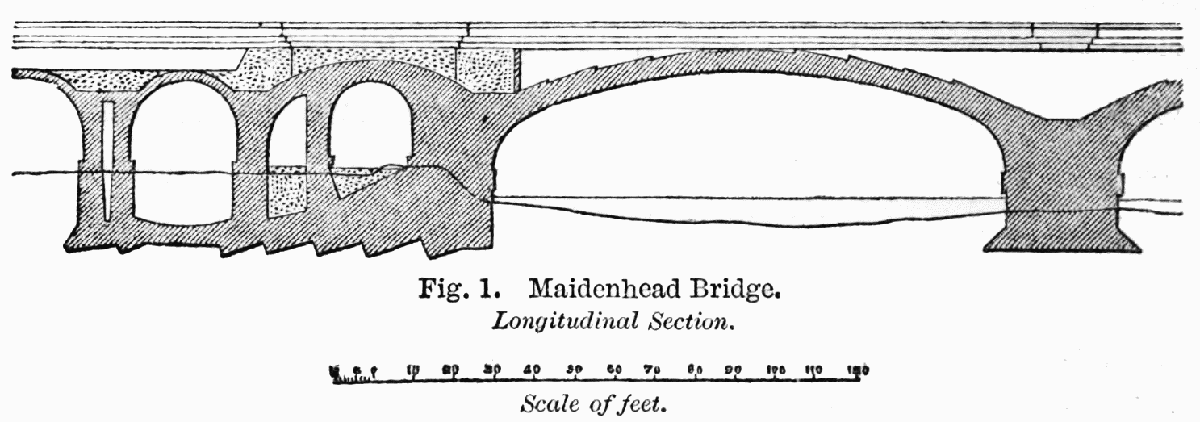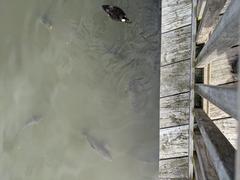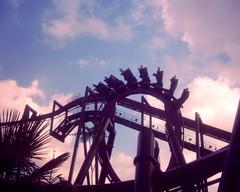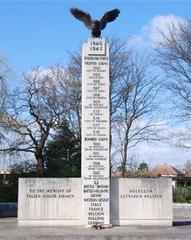
Comprehensive Guide to Visiting Maidenhead Railway Bridge, Slough, United Kingdom
Date: 01/08/2024
Introduction
The Maidenhead Railway Bridge, also known as the Sounding Arch, stands as a monumental achievement in the history of civil engineering. Designed by the legendary Isambard Kingdom Brunel, this bridge is not only a crucial component of the Great Western Railway but also a testament to 19th-century innovation. Completed in 1838, the bridge features two of the flattest and widest brick arches ever constructed, a design that initially stirred skepticism but ultimately solidified Brunel’s reputation as a pioneering engineer. The bridge’s significance is further magnified by its depiction in J.M.W. Turner’s famous painting ‘Rain, Steam and Speed – The Great Western Railway’ and its status as a Grade I listed structure (Wikipedia; Network Rail).
This comprehensive guide aims to provide visitors with essential information on the Maidenhead Railway Bridge, including its historical background, architectural marvels, and practical tips for an enriching visit. Whether you are a history enthusiast, an architecture aficionado, or simply looking for a picturesque spot to explore, this guide will help you make the most of your visit to one of Maidenhead’s most iconic landmarks. From travel tips and nearby attractions to special features and guided tours, every aspect of the Maidenhead Railway Bridge is covered to ensure a memorable experience.
Table of Contents
- Introduction
- History and Significance
- Visitor Information
- Special Features
- Preservation and Heritage
- FAQ
- Conclusion
History and Significance
Design and Construction
The Maidenhead Railway Bridge, designed by the renowned civil engineer Isambard Kingdom Brunel, was completed in 1838 and brought into use on July 1, 1839. It was part of Brunel’s ambitious plan for the Great Western Railway, which aimed to connect London and Bristol with minimal gradients (Wikipedia).
The bridge’s design was revolutionary for its time, featuring two wide, low-rise arches made entirely of red brick. Each arch spans 128 feet (39 meters) with a rise of only 24 feet (7.3 meters), making them the flattest brick arches ever constructed. This innovative design initially attracted criticism and skepticism regarding its stability. To address these concerns, the centring for the arches was left in place until a heavy storm in late 1839 destroyed it. Remarkably, the arches remained standing, thereby vindicating Brunel’s design (Network Rail).
Historical Context
During the 1830s, the Great Western Railway Company, under Brunel’s guidance, developed a 118-mile (190 km) railway line between London and Bristol. The Maidenhead Railway Bridge was a crucial crossing point over the River Thames between Maidenhead, Berkshire, and Taplow, Buckinghamshire. The bridge’s construction was part of a broader effort to maintain gentle gradients and level ground throughout the railway line, ensuring efficient and smooth travel (Wikipedia).
Engineering Marvel
The Maidenhead Railway Bridge was an engineering sensation when it was completed. Its low-rise arches were not only the flattest but also the widest brick arches in the world at the time. The bridge’s design allowed for minimal obstruction to the river’s navigable channel and towpath, which was a requirement set by the Thames Navigation Commissioners. Brunel’s design philosophy of minimal gradients was not compromised, as the inclined approaches towards either end of the bridge were only 1 in 1,320, or 0.076 percent (Network Rail).
Cultural Significance
The Maidenhead Railway Bridge holds a special place in British cultural history. It was famously depicted in J.M.W. Turner’s painting “Rain, Steam and Speed – The Great Western Railway,” completed in 1844 and now housed in the National Gallery, London. The painting captures the essence of the Industrial Revolution and the transformative impact of railway travel on society (Wikipedia).
Modern Recognition
In July 2012, the Maidenhead Railway Bridge was upgraded to a Grade I listed structure, recognizing its historical and architectural significance. The bridge remains a vital part of the Great Western Main Line (GWML), carrying trains between London Paddington and Reading. During the 2010s, the tracks across the bridge were provisioned with overhead line equipment to allow for electric traction, ensuring the bridge’s continued relevance in modern railway infrastructure (Wikipedia).
The Sounding Arch
One of the most intriguing features of the Maidenhead Railway Bridge is the right-hand arch (facing upstream), known as the Sounding Arch. This arch is famous for its spectacular echo, which has fascinated visitors for generations. The Thames towpath passes directly under this arch, making it a popular spot for walkers and tourists to experience the unique acoustic phenomenon (Wikipedia).
Legal and Economic Impact
The construction of the Maidenhead Railway Bridge had significant legal and economic implications. In 1843, the Corporation of Maidenhead, owners of the turnpike toll-bridge, sued the Great Western Railway for the maximum statutory compensation of £2,500 for loss of tolls due to the new railway line diverting traffic away from the toll bridge. Although the Great Western Railway initially defended the claim on technical grounds, they eventually paid the compensation in full before the trial, avoiding additional interest and costs (Wikipedia).
Visitor Information
Ticket Prices and Opening Hours
While there are no ticket prices for visiting the Maidenhead Railway Bridge itself, visitors can enjoy the scenic views and historical ambiance at any time. The Thames Path, which runs under the bridge, is accessible 24 hours a day. However, it is advisable to visit during daylight hours for safety and the best photographic opportunities.
Travel Tips
- How to Get There: The bridge is easily accessible from Maidenhead Station, which is served by regular trains from London Paddington and Reading. From the station, a short walk will take you to the Thames Path and the bridge.
- Best Time to Visit: Spring and summer are ideal for visiting, as the weather is mild and the surrounding greenery is in full bloom.
- What to Bring: Comfortable walking shoes, a camera for capturing the stunning architecture, and perhaps a picnic to enjoy along the Thames.
Nearby Attractions
- Maidenhead Heritage Centre: Learn more about the local history and the construction of the bridge.
- Cliveden House: A beautiful estate with gardens and woodlands, located a short drive from Maidenhead.
- Boulter’s Lock: A historic lock on the River Thames, perfect for a leisurely stroll.
Accessibility
The Thames Path is generally accessible to visitors of all abilities, though some sections may be uneven. The path under the bridge is flat and suitable for wheelchairs and strollers.
Special Features
Special Events
- Maidenhead Regatta: The bridge is a key feature in the annual Maidenhead Regatta, marking the approximate finish line of the rowing races.
Guided Tours
Occasionally, guided tours are organized by local history groups or the Maidenhead Heritage Centre, offering deeper insights into the bridge’s history and engineering marvels.
Photographic Spots
The best photographic spots include the Thames Path under the bridge and the nearby riverbanks, which offer panoramic views of the structure.
Preservation and Heritage
The historical importance of the Maidenhead Railway Bridge is preserved through various initiatives. Historic images of the original architectural drawings have been captured and published on a new Network Rail virtual archive, celebrating the heritage of 19th-century engineering and providing public access to a special selection of records (Network Rail Media Centre).
In 2007, the bridge was the subject of a special exhibition at the Maidenhead Heritage Centre to mark its 230th anniversary. This exhibition highlighted the bridge’s historical significance and its role in the development of the Great Western Railway (Wikipedia).
FAQ
What are the visiting hours for Maidenhead Railway Bridge?
The bridge and the Thames Path are accessible 24 hours a day, though it’s best to visit during daylight hours.
Is there an admission fee to visit Maidenhead Railway Bridge?
No, there is no admission fee. Visitors can enjoy the bridge and the surrounding area free of charge.
Are there guided tours available?
Yes, occasionally guided tours are organized by local history groups or the Maidenhead Heritage Centre.
What nearby attractions can I visit?
Nearby attractions include Maidenhead Heritage Centre, Cliveden House, and Boulter’s Lock.
Conclusion
The Maidenhead Railway Bridge stands as a testament to Isambard Kingdom Brunel’s engineering genius and the transformative power of the railway during the Industrial Revolution. Its historical, cultural, and architectural significance continues to be recognized and celebrated, making it a must-visit landmark for anyone interested in the history of engineering and railway travel.
For more updates and information, be sure to follow our social media channels or download our mobile app Audiala.
References
- Wikipedia. Maidenhead Railway Bridge. Retrieved from https://en.wikipedia.org/wiki/Maidenhead_Railway_Bridge.
- Network Rail. The History of the Maidenhead Bridge. Retrieved from https://www.networkrail.co.uk/who-we-are/our-history/iconic-infrastructure/the-history-of-the-maidenhead-bridge/.
- Visit Thames. Brunel’s Bridge. Retrieved from https://www.visitthames.co.uk/things-to-do/walking/water-walks-and-winter-warmers/brunels-bridge.






